Llamas are very calm, gentle animals who spend their days grazing or
chewing their cuds. They are generally very quiet and somewhat aloof. They will hum
to communicate with their babies or to express stress. They can make a screaming distress
call when threatened by predators. Normal llamas do not kick, bite, or spit at people
unless they are frightened. They will spit at each other to establish dominance within the
herd. Female llamas usually raise their noses in the air and blow air as a warning. Once
she has established herself as the queen llama, the other llamas usually back off after
this warning. Bred females will spit at a male to say, "Don't even think about
it." An experienced male will take heed. Since llamas are social animals, they are
very unhappy raised as single animals. They prefer the companionship of other llamas, but
will adjust to goats or sheep.
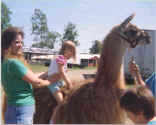
Safe with children. |
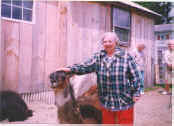
A thrilling outing. |

Fun to pet. |
CARE
Llamas eat grass, hay, grain, and mineral supplements. Each llama eats about one bale of
hay per week. Four llamas can be pastured per acre of land. Hay and water should be
available at all times. Heat and flies bother them more than cold. Llamas need shelter
from the sun and cold wind. Female and baby llamas can be pastured together. Males are
usually separated from each other because they will fight for breeding rights if females
are present. Males raised without the presence of females can often be housed in the same
pasture. Llamas are very healthy and easy to care for. They should have annual
inoculations of CD and Tetanus and regular worming.
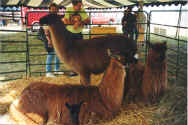
Show time. |
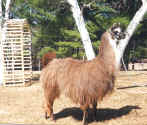
Out for a stroll. |

Snack time. |
PHYSICAL APPEARANCE
Llamas are beautiful, elegant animals that originate in South America. They are related to
the camels, alpacas, guanacos, and vicunas. They live to be 15-25 years old, and weigh
200-450 pounds, with heights of 36'-46' at the shoulder and 5'-7' at the head. Although
size differences are normal, well conformed llamas will have long necks, straight back
lines and straight legs. Llamas come in solid colors including white, black, gray,
and many shades of brown. Others have spots or a variety of markings. These llamas are
sometimes called appaloosas or paints. Llama wool may be short, medium, or long. Some
have a single fleece, which has finer fiber but gets dirty faster. Some have a double
fleece, with the softer hairs under courser guard hairs that keep the llama dry, clean,
and shining. The wool may be shorn (a necessity for heavy-wooled single-fleeced animals)
or combed from shedding double-fleeced animals, leaving the guard hairs on the llamas.
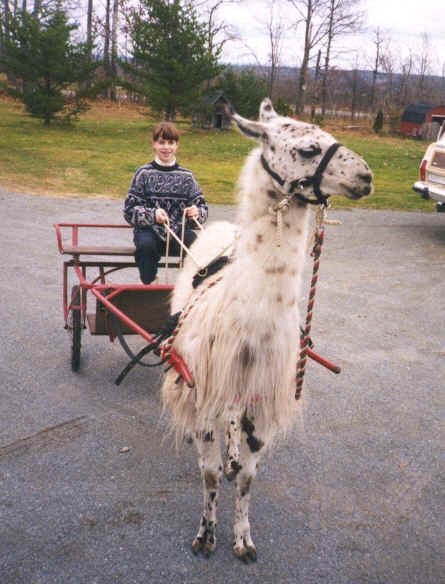
Go for a ride? |
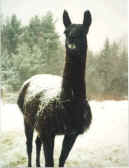
Or play in the snow? |
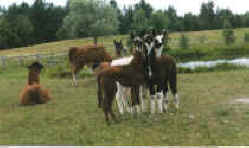
Get ready, set, GO! |
REPRODUCTION
Females are bred at 18-24 months. Since they are induced ovulators that do
not come in season, they can be bred at any time. Most breeders avoid births during very
cold or very hot months. In Maine, this limits the breeding and birthing seasons to
late spring and early autumn. The gestation period is 340-360 days. They usually have only
one baby, called a cria, that weighs from 20-35 pounds. They seldom have birthing
problems, and can be bred back within a month. Babies are usually standing up and nursing
within 30 minutes. Males are able to breed at 2-3 years old. Babies are usually weaned at
about 6 months old.
USES
Because of their gentleness, intelligence, and curiosity, llamas make safe
and enjoyable pets. They can be easily trained to wear halters, lead with a rope, load in
a trailer, and navigate obstacles. Some llamas have been trained to pull carts in single,
double, or triple hitches. They are used as pack animals on hikes, carrying as much
as 100 pounds. They are not ridden. Since llamas have soft padded feet with split hoofs,
they are sure-footed and easy on the environment. Llamas are used as guard animals to
protect sheep and goats from predators such as coyotes. Male llamas used for guards must
be gelded. Llama fiber is lanolin and grease free, making light-weight warm yarn for
sweaters, scarves, hats, and mittens. Hand spinners enjoy spinning llama wool by itself or
mixed with other fibers. Most people are not allergic to llama fiber. Llamas can be
shown and judged at local fairs by 4-H students and adults. Since llamas are gentle, they
are safe for children to handle.Many people enjoy llamas because they are great stress
relievers. Raising llamas can be a profitable business. Most of all, it is fun.